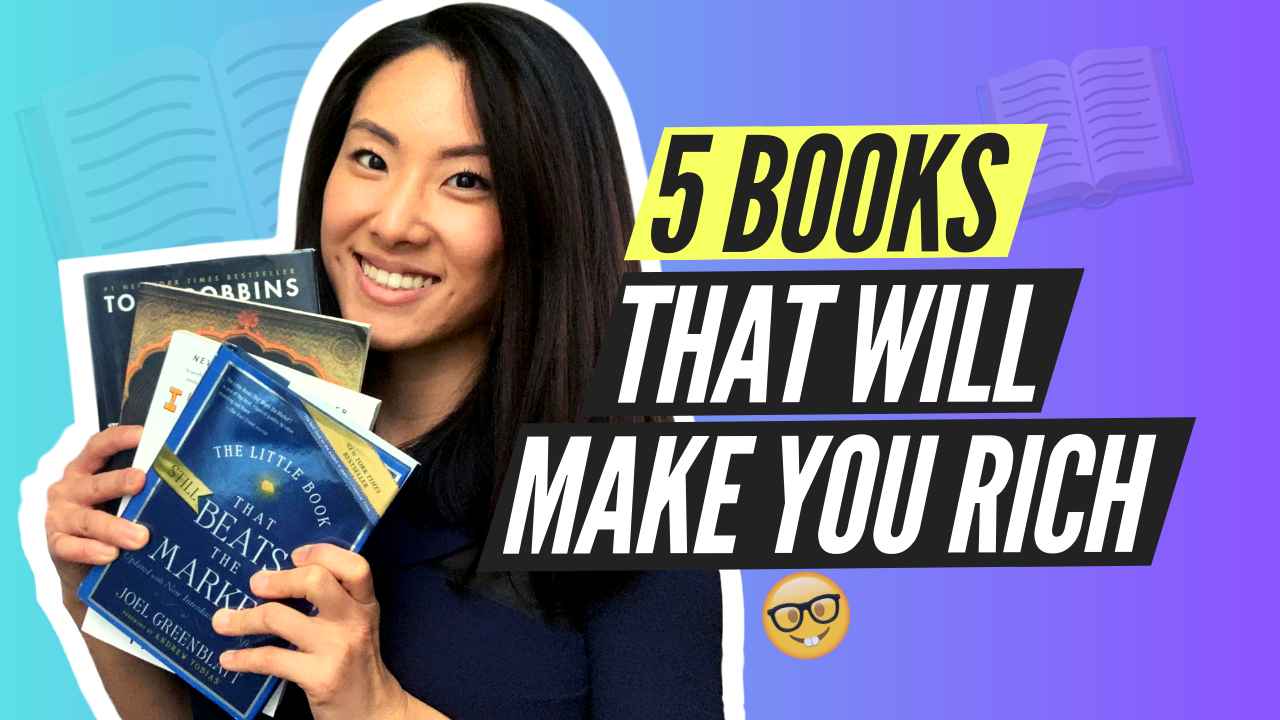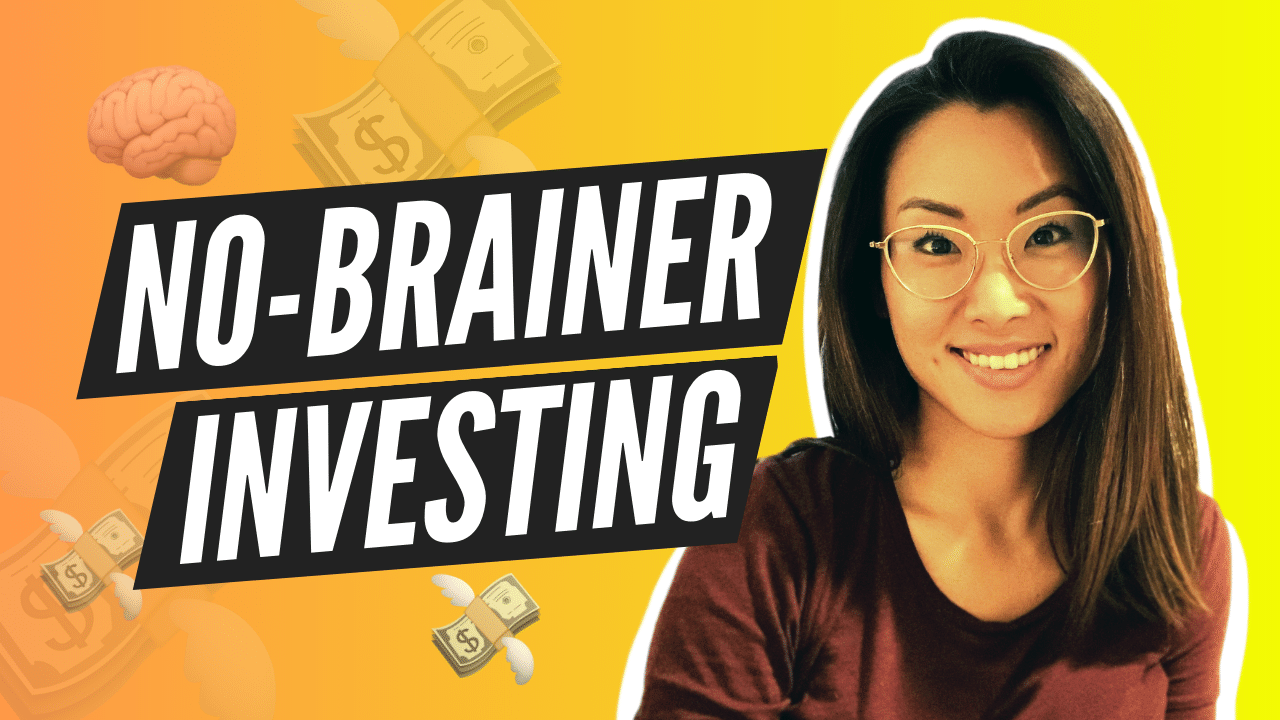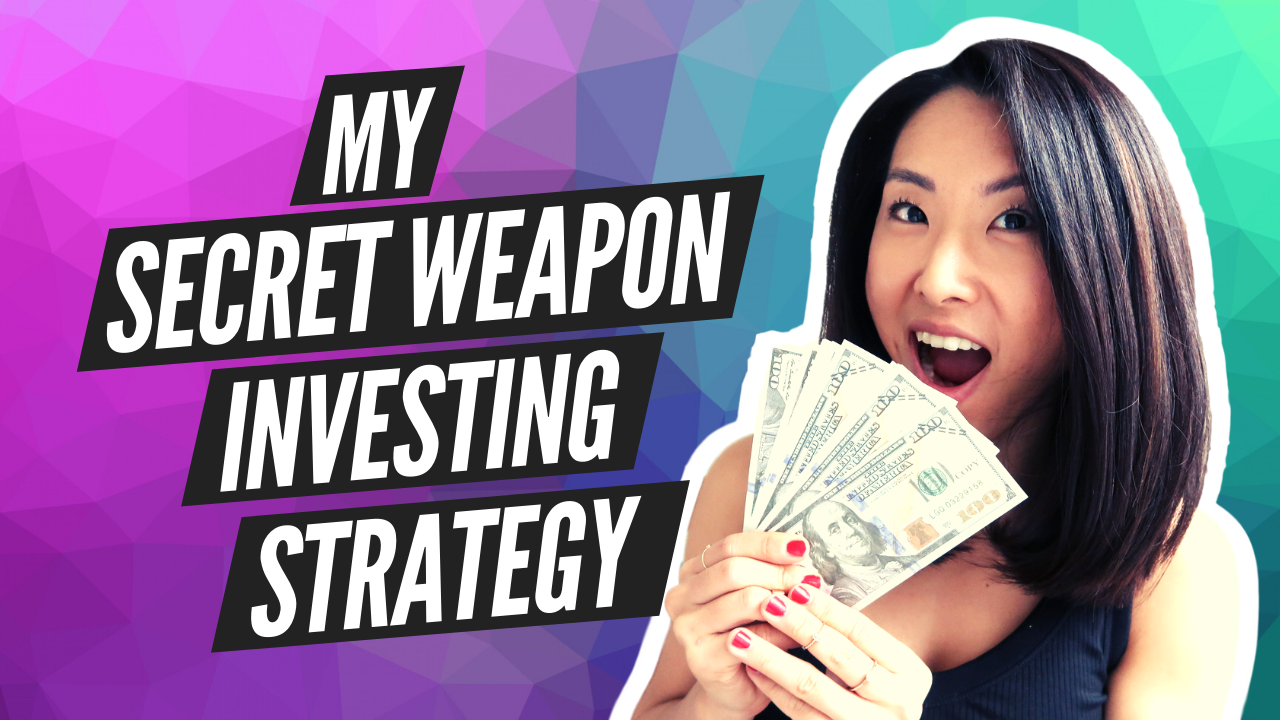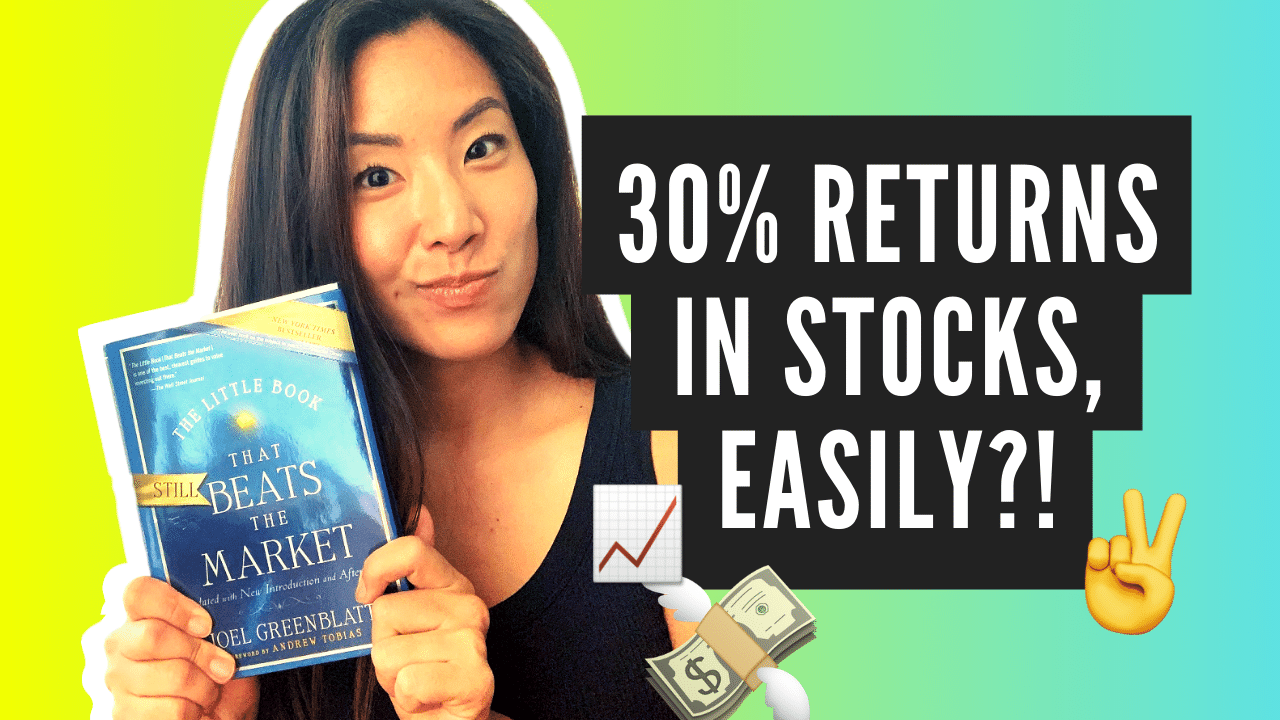If invested right, you can double your $1000 in 7 years! If you’ve never invested before and could use a super beginner-friendly rundown of your investing options, this post was MADE for you. I’m going to show you 10 ways to invest $1000 so you can start putting your money to work. Watch the video below or keep reading!
#1 – Invest in an index fund
First, let me step back for a second and explain what an index is. An index is a tool that quickly tells you how the stock market is doing. There are lots of indexes out there (like the Dow, Nasdaq, and a bunch of others), but let’s use the S&P 500 as an example, because it’s the most widely-used stock market index.
The S&P 500 is a sample set of the 500 largest U.S. companies, all rolled up into one easy-to-read average price. So if you wanted to know how the U.S. stock market performed in 2018, rather than looking up all 500 stocks individually, you can just look up where the S&P 500 started the year and ended the year, and that would tell you how the stock market did in 2018. Although there’s a lot more than 500 stocks in the U.S. (there’s actually 3,671!) the S&P 500 is a pretty accurate barometer of how the OVERALL U.S. stock market is doing.
So back to index funds. An index fund is an investment vehicle that mirrors an index. Remember, the S&P 500 index is just a calculated average of 500 different stock prices – so you can’t invest in the S&P 500 index. But you CAN invest in an S&P 500 index FUND.
When you invest in an S&P 500 index fund, you immediately become a part owner in each of the 500 companies in the index. And if the S&P 500 index goes up 5%, your investment in the index fund also goes up 5%. If the S&P 500 goes down 5%, your investment also goes down 5%.
There’s 2 really good reasons to invest in an index fund:
- The 1st reason is that you get safety in numbers. With an index fund, you don’t have to know how to pick stocks. Because the S&P 500 consists of 500 stocks, widely diversified across different industries – you don’t have to be a genius to benefit from the wealth-creating capabilities of the stock market. All you have to do to get on that long-term upward trend is to invest in an index fund. So if you’re not interested in researching individual stocks, you have to rely on safety in numbers. This strategy is also known as diversification, and it works because although not all stocks go up over the long-term, the overall market does go up over the long term.
- The 2nd reason is that index funds offer automatic reinvestment. Once you make your initial $1k investment, you’ll probably want to keep adding to your nest egg, so what you can do is set up automatic monthly contributions from your bank account, and the index fund will reinvest this additional cash back into the fund every single month, at no additional cost! So you can literally just set it and forget it, because everything is done for you.
There’s a few good S&P 500 index funds out there, and it doesn’t really matter which one you get. They all track the S&P 500 very closely, and they are all very low-cost.
- SWPPX: https://www.schwabfunds.com/public/csim/home/products/mutual_funds/summary.html?symbol=SWPPX
- FXAIX: https://fundresearch.fidelity.com/mutual-funds/summary/315911750
#2 – Invest in an ETF
ETFs – a.k.a. exchange traded funds – are very similar to index funds. Just like index funds, ETFs track an index. The only difference is in how they are traded.
For example – SPY is an S&P 500 ETF that is the exact equivalent of the FXAIX, an S&P 500 index fund. Both of them are pooled investment vehicles that give you easy access to a large selection of stocks. So you get access to hundreds and thousands of different stocks, all with ONE easy purchase. But with the index fund, you can only buy and sell your shares once a day.
With the ETF, you can buy and sell any time the stock market is open.
Some people prefer ETFs because they like being able to buy and sell their shares whenever they want. A big downside to ETFs though is that they don’t offer automatic reinvestment. So if you want to keep adding to your portfolio every month, you’d have to buy more shares every month with that additional money otherwise your cash will just sit there doing nothing. That comes with trading commissions, which really add up if you do it every month. So if you’re stuck between ETFs and index funds, just go with index funds.
#3 – Invest using a “robo-advisor” app
Ellevest, Stash, Acorns, Betterment – there’s a bunch of new apps out there that make it really convenient for you to invest, and none of them have investment minimums, so with $1000 you are good to go. These apps make it SUPER easy.
You hook up your bank account, transfer over some money, and boom – your money gets invested. I love Acorns because of its cute easy-to-navigate user interface and the ability to invest by rounding up the purchases you make on your debit or credit card.
All these apps essentially do the same thing. They ask you some basic questions about your age, your financial goals, and your time horizon for those goals. Then based on your answers to these questions, they invest your money in a pre-packaged portfolio tailored to your investor profile. These pre-packaged portfolios combine a handful of ETFs that give you well-rounded exposure to a variety of stocks and bonds.
For example, if you invested $1000 with Acorns in their moderately aggressive portfolio, here’s what it would look like:

A lot of these ETFs cost over $100 per share, but thanks to a technology called fractional share investing, you can still get a fully diversified portfolio containing all of these ETFs, even with a $5 investment.
It’s important to note that apps like Acorns give you very little control over what’s in your portfolio. You only get to choose between their pre-packaged portfolios, and you can’t just buy whatever stock you want. It’s the same with all the other roboadvisors – you’re basically giving up control in exchange for convenience and simplicity. So if you want to put your money to work and not have to think about it too much, then definitely consider investing with one of these apps.
#4 – Invest in stocks using the “Magic Formula”
If you’re more of the DIY type, you might prefer investing in individual stocks.
And you probably know this, but the stock market is at all-time highs right now. It’s made record highs and has been on the longest bull run in history [B-ROLL]. That makes people nervous, because nobody wants to be that person who bought in at the top right before everything crashes. So I don’t know about you, but I’m not comfortable with buying stocks at the top of the market right now. So what’s a girl to do?!
Luckily there’s a solution – and it’s called Magic Formula Investing. Based on two simple financial metrics:
- Earnings yield
- Return on capital
The Magic Formula filters through the thousands of companies you COULD invest in and shows you only the stocks that are priced cheaply relative to their earnings potential. The idea is that if you’re buying GOOD companies for CHEAP, then your risk is super low because there isn’t much room for the stock price to go any lower.
Here’s an analogy: You’re in the grocery store and you buy a basketful of stuff. Most of the items weren’t on sale, and let’s say your total at the cash register is $50. And if you shop at Whole Foods like I do, that $50 probably only got you like 2 apples and a piece of lettuce. Now let’s say you come back to Whole Foods the next day, and ALL the items you bought the day before are now 50% off! You’re super annoyed because you COULD have gotten the 2 apples and your piece of lettuce for only $25, instead of $50. If you’d waited for things to go on sale before buying, imagine how happy you would have been to get your groceries at a 50% discount. And because the sale price is so cheap – you know you’re getting it at the absolute lowest price.
This is exactly what Magic Formula investing is all about. You buy stocks that are already on sale, so that you have the security of knowing that the stock price isn’t going to go much lower. If you want to learn more about this strategy, then check out this book: “The Little Book that Still Beats the Market”. It’s only like 150 pages long, and it’s written by a really smart fund manager named Joel Greenblatt. He explains the whole strategy step-by-step, and it’s all written in plain English. I read it in one day and I highly recommend it.
#5 – Invest in the money market
Maybe you’re not ready to invest in the stock market yet. Maybe you just want to park your cash somewhere until you decide what you wanna do with it. Then consider putting it into a money market fund. The money market is a place to park your cash short-term and earn a decent yield of 2-3%. When you invest in the money market, you’re lending your cash to short-term borrowers (meaning loans with maturities less than 1 year). So it’s a very safe place to keep cash because there’s hardly any interest rate risk, and generally very little credit risk. And I don’t know about you, but earning 2-3% on my money is WAY better than my savings account, which pays close to zero!
If you ever need the cash, you can just get your cash out the next day, but meanwhile, the money isn’t just sitting there doing nothing. Although there’s different ways to invest in the money market, funds are the best way for individuals to access the money market because they’re low-cost and diversified, which maximizes your return while reducing your credit risk. This is not a recommendation to buy – but some popular low-cost funds you can look into to jumpstart your research are FDLXX and VMFXX.
#6 – Invest in your emergency fund
This is really boring personal finance advice, but it’s actually really important for investing. An emergency fund gives you a cushion so that you’re never forced to sell your investments to pay for an unforeseen expense. Having this cash cushion is CRITICAL, because if you’re strapped for cash during a market downturn, you’d have to sell your investments to come up with cash, and then you won’t be invested in the market anymore when it recovers. Investing success is all about the long-term, so you never want to tie up cash for short-term needs in the stock market.
A good rule of thumb is 3 months worth of expenses in your emergency fund, but $1000 makes a GREAT starter emergency fund. You can always add more to it later.
#7 – Invest on a real estate crowdfunding platform
Traditionally, real estate requires a good amount of capital, but thanks to crowdfunding technology, now you can invest in real estate with just $1k. Fundrise is a platform that crowdsources funds online from small investors, and it uses that money to buy investment property all over the U.S.
What I like about Fundrise – and real estate investments in general – is that they offer a balance of dividends and growth. Real estate generates steady income from rents, but it also appreciates in value. Since I’m young, I definitely want growth, and the dividends are a bonus because I can either reinvest them right back into the fund, or just spend it on other things. The minimum investment at Fundrise is only $500, and the whole onboarding process is super easy. Before you make an investment, you can see the photos and addresses of the projects your money will be invested in, review the financials, and you can even drive by to look at the properties in person.
#8 – Invest in a REIT
Another fun way to invest in real estate is through REITs – or real estate investment trusts. REITs are companies that own income-producing real estate. REITs trade like stocks – so they trade on an exchange and they have a stock ticker symbol. REITs are a great way to start “dipping your toes” into real estate. And because of their focus on income-producing real estate, REITs usually pay high dividends and are great for people who need income but also still want long-term growth.
Have a look at SPG, or Simon Property Group. This is a well-known REIT that owns commercial properties all over the United States. Their dividend yield right now is about 4.5% – that means on a thousand-dollar investment, you’ll get a dividend check for $45 every year!
The biggest difference between REITs and crowdfunding platforms like Fundrise is the transparency and the type of properties owned. Since REITs are publicly traded companies, so they have MUCH stricter requirements for financial reporting. Also, REITs are required to focus on income-producing properties, whereas Fundrise deals are allowed to be more speculative and growth-focused.
#9 – Invest in paying down debt
OK this isn’t really an investment in the traditional sense, but when you get rid of debt, those monthly payments can go towards building up your investments instead! I used to have 6-figure student debt, and my monthly payments were almost $1k! Before I got serious about getting out of debt, I literally had zero investments. But now that most of it is paid off, I have $800 extra every month to save and invest, and that’s when my investment portfolio really took off.
On a standard student loan at 6% interest, reducing your principal by $1k frees up $10 of extra cashflow a month. You can then automate a $10 transfer into your investment account every month, and BOOM you’re on your way to building up a nest egg. So if debt is preventing you from being able to consistently put away money towards your savings and investments, then the best way to invest your $1k might be to start paying down your debt!
#10 – Invest in yourself
Last but not least – the ultimate investment is investing in YOURSELF. Now hear me out! Einstein once said:
“We can’t solve problems by using the same kind of thinking we used when we created them.”
In other words, the person who has $1M in the bank cannot be the same person as the one that had $100 in the bank. I’ve invested tens of thousands of dollars in personal development programs, meditation retreats, workshops, online courses, coaches – you name it! And if I hadn’t done that, I probably never would have gotten out of debt and taken action on my investing goals. When you invest in yourself, with coaches, books, and personal development programs, then you upgrade your mental software so that you can think differently, think bigger, and break through any of the invisible and subconscious barriers you have in your life right now. Here are some of the programs that have made a big difference in my life, so you can check them out if you’re interested!
Alright now I want to hear from you!
How are YOU planning to invest your first $1K?
Join me in the comments below and let’s motivate each other to get started investing! If you liked this post, please share it with your friends so we can open up the conversation around money AND build a sisterhood of financially savvy, empowered women.
Always remember to go after your dreams unapologetically and to live life on YOUR terms. Cheers!






